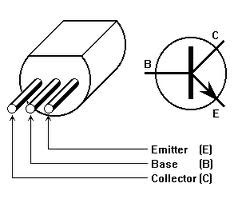Electronics/Transistor
Transistor
How Does a Transistor Work? - YouTube - http://www.youtube.com/watch?v=IcrBqCFLHIY
How to Connect a Transistor in a Circuit for Amplification - http://www.learningaboutelectronics.com/Articles/How-to-connect-a-transistor-in-a-circuit-for-amplification
Basic Transistor Circuits - http://www.pcbheaven.com/wikipages/Transistor_Circuits/
Transistors 101 - http://sunburst.usd.edu/~schieber/psyc770/transistors101.html

NPN easy remember - not pointing in
NPN, looking at flat edge, left pin is collector (+), center is base, and right is emitter (-)

2N2222 NPN transistor


Darlington pair
"A single bipolar transistor cannot have both high gain and high collector current. A Darlington pair is a special arrangement of bipolar transistors that combines a high-gain transistor with a high-current transistor. The combined transistors allow both a higher gain and a larger amount of current to flow than would be possible with a single transistor. Darlington pairs are often used to drive motors. They can be bought packaged as a single discrete component or packaged as a transistor array, consisting of several transistors in a single integrated circuit (IC) (such as ULN2803 and ULN2003)." [1]
